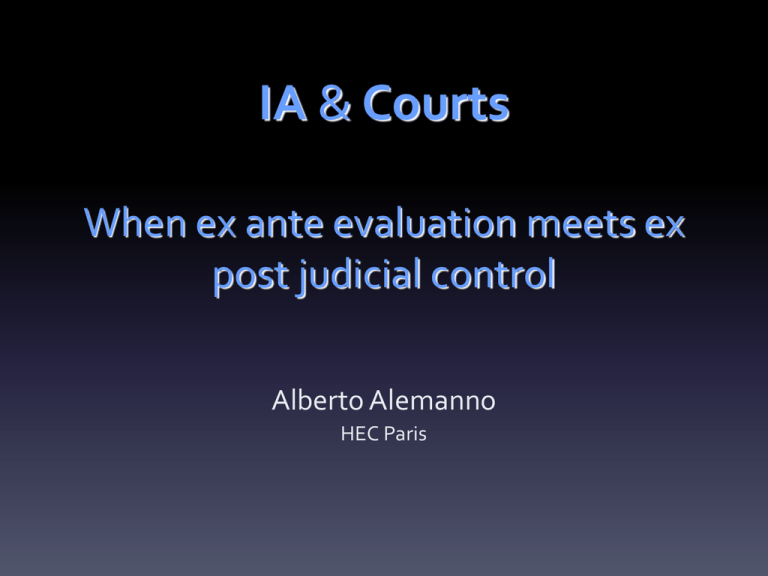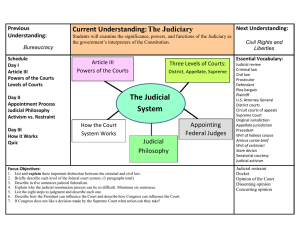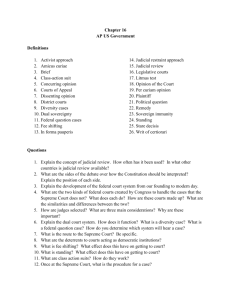IA When ex ante evaluation meets ex post judicial control
advertisement

IA & Courts When ex ante evaluation meets ex post judicial control Alberto Alemanno HEC Paris focus courts as actors of IA system claim evidence-based policy making evidence-based judicial making research questions 1. When IA meets courts ? 1. What happen when they meet? 1. Which role IA into judicial review? When Direct encounter: Legality of IA questioned before Courts Indirect encounter: Legality of EU act questioned via IA Direct Encounter • IA is missing/not properly performed/revised • Admissibility issue: – Legal status? – Reviewable act? » Mere ‘preparatory act’ – Legal benchmark? Instance of maladmnistration? 229 TFEU Complaints before the Sec-Gen? Indirect Encounter • Legality of EU act questioned via IA • EU act breached IA: –Not performed or badly performed –Not based on IA, it departs from it Indirect Encounter (1) ‘Procedural’ check Claim: illegality EU act IA not performed/badly performed Is IA a binding step in decision-making? Commission is not legislator, only Council/EP Probably not, as shown by its soft law nature « essential procedural requirement » under case law recognising selfimposed rules self-binding effect? IA guidelines offer legal benchmark: Proportionate analysis/Minimum standards for consultation Indirect Encounter (2) ‘Substantive’ check: Claim: illegality of EU act as it departs from IA ‘legality check’ (e.g. conferral, proportionality, subsidiarity) Is there a duty to stick to the outcome of IA? Should there be a rational relation btw the 2? Afton – AG Kokott The Commission’s IA analysis, “exercised on the basis of its own discretion, does not prevent the other institutions participating in the legislative procedure from drawing different conclusion from the available information. Should the Court criticise the difference in opinion between the Commission, on the one hand, and the Council and the Parliament, on the other, the institutional balance...would be called into question”. yet IA ‘legality check’ may play a role in the judicial review of EU act Which: IA as ‘aid to the parties’? Proportionality 1. Suitability 2. Necessity 3. stricto sensu ? Onus on the plaintiff (probatio diabolica) Quid if IA contains CBA (or some quantification) Easier for the parties to submit evidence More focus on third limb nature of the principle might chance What: IA as an ‘aid to Courts’? • Spain v Council, in examining proportionality, stated that, notwithstanding limited judicial review, EU institutions must « produce and set out clearly the basic facts which had to be taken into account as as the basis of contested act » What better way than producing a IA? Conclusions WHEN: pre-draft & judicial review interact WHICH: IA may serve as analytical support for Courts, under parties’ pressure or sua sponte WHAT: Impact on the nature of general principles and their interpretation and in turn into the IA process itself Prediction: more evidence-based legislation more informed judicial scrutiny regardless of IA ‘juridification’ IA publication legitimate expectations policymakers COURTS bibliography • Alemanno, Alberto, The Better Regulation Initiative at the Judicial Gate: A Trojan Horse within the Commission's Walls or the Way Forward?, European Law Journal, Vol. 15, No. 3, 2009. • Alemanno, Alberto, A Meeting of Minds on Impact Assessment: When Ex Ante Evaluation Meets Ex Post Judicial Control, European Public Law, Vol. 17, No. 3, 2011. • Alemanno, Alberto and Meuwese, Anne C.M., Impact Assessment of EU Non-Legislative Rulemaking: The Missing Link of 'New' Comitology, European Law Journal, Vol. 19, No. 1, 2013.







